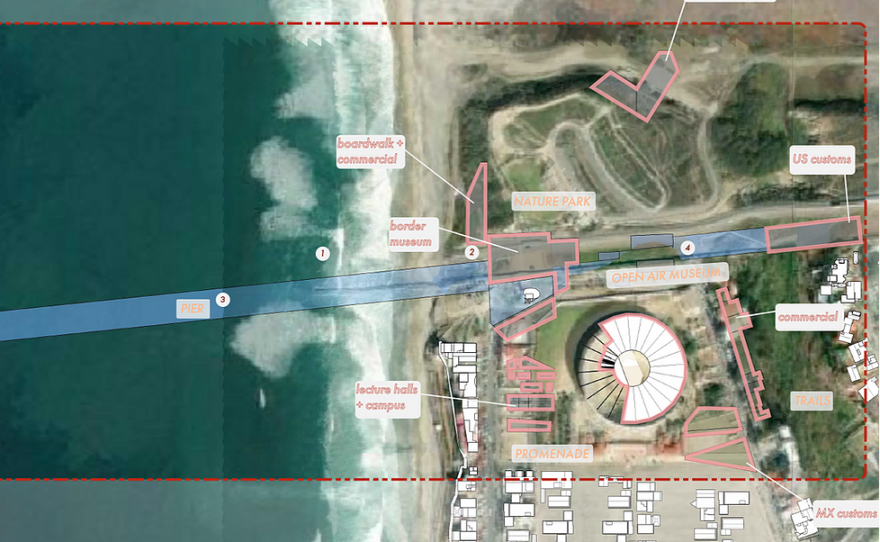This week, Friendship Park turns 50 years old.
But the binational park at the U.S.-Mexico border fence will have to celebrate its anniversary without being fully opened.
A group of activists on both sides of the border is working to change that.

“U.S. Border Patrol had given us every reason to believe that when the pandemic came to an end, or was winding down, that once again people would be able to enter Friendship Park,” said John Fanestil, the pastor of Border Church, a binational service that meets outdoors at Friendship Park every Sunday. “As you can see, the California state park and surrounding areas are open. And people are arriving. I've met several families who were wishing to be able to visit with their loved ones in Mexico… But the park's federal property is still closed.”
Friendship Park is located inside Border Field State Park, the California state park at the southwestern-most point of the U.S. It’s the place where people on opposite sides of the U.S.-Mexico border can go to meet up in-person.
The folks who use the park as a meeting place are often those separated by immigration status; maybe they’re on parole and can’t leave the country, or maybe their citizenship status is in flux so they can’t travel south to Mexico and their families and friends in Mexico aren’t able to travel north to the U.S.
When the pandemic hit, Friendship Park was closed alongside lots of other things across the globe.
But Fanestil and others from the Friends of Friendship Park, a group of activists that’s worked for years to keep the park open and accessible, say it’s well past time to reopen access to the space inside the two border fences, a spot inside the park known as "Friendship Circle." Specifically, they say Border Patrol should open a gate that lets people inside Friendship Circle from 10 a.m. to 2 p.m. on Saturdays and Sundays, which are the posted hours that the U.S. Border Patrol agreed to in past negotiations.
The Friends of Friendship Park had really hoped the park would be fully reopened for the 50th anniversary of the park and the long list of events they’ve planned to mark the occasion.

But Jacob MacIsaac, a spokesman for the San Diego sector of the U.S. Border Patrol, said in a written statement that, for now, they will not be reopening access to Friendship Circle.
“A large portion of our workforce has been allocated to the care and processing of the influx of undocumented migrants that are entering our country illegally,” the statement read. “This has left San Diego sector with a limited number of Border Patrol agents to respond to enforcement related incidents in border areas. Additionally, this has negatively impacted our ability to perform non-enforcement duties to include opening Friendship Circle. We continually monitor and assess immigration flow and manpower. Unfortunately at this time, we cannot reopen Friendship Circle until we have sufficient manpower to ensure it is safe for everyone.”
Selene Gutierrez was one of approximately 50 people who showed up to a protest and march back in June at Border Field State Park. Participants were there to show their support for reopening Friendship Park.
“Close to 11 years ago, my younger sister was deported and this is the only place that I can come and get to see her,” Gutierrez said.
Gutierrez is a recipient of DACA, or Deferred Action for Childhood Arrivals. Those with DACA were brought across the border as kids and have been allowed to stay and work in the U.S., but haven’t been given full citizenship rights, so they cannot easily travel internationally.
“Right now, Friendship Park is closed, but I'm hoping that it will be reopened by the time that she comes to Tijuana so I can see her,” she said. “I do have a new nephew and it'll be my first time that I get to meet him.”
At the protest, Gutierrez and others hiked to the beach, then marched in silence to the border fence. Protestors in Tijuana did the same thing. The event was a way to show the U.S. Border Patrol how many people on both sides of the border wall want the park to be reopened.
“We've had a lot of negotiations with Border Patrol over the years,” said Jim Brown, an architect and member of Friends of Friendship Park who was at the protest in June.
Brown just released drawings and plans for a much more open, border-fence-free Friendship Park. His plans for the future of the binational park are currently being exhibited at The Athenaeum in La Jolla and Bread & Salt in Barrio Logan. The plans will also be on view at the big 50th anniversary celebration at Friendship Park happening on Saturday, Aug. 22.

“Border Patrol's excuse of not having the manpower is complete nonsense,” Brown said as he marched out toward Friendship Park. “They have the money, they have the manpower. We just have to point that out to them and make them do it and live up to their responsibilities…. This is too important of a meeting place. It needs to be open immediately.”
Robert Vivar, a deportee in Tijuana who helps run Border Church and has become a well-known immigrant advocate in San Diego and Tijuana, has used Friendship Park in the past to meet up in-person with his own family in the U.S. He says not being able to see his kids and grandkids grow up has been painful, but that being able to meet up with them when the gates of Friendship Park were opened has been part of what keeps him motivated to keep up his advocacy for other deportees and migrants like him.

"A couple of years after I got deported, I was able to see my grandkids through the border," he said. "I was able to hug my son and my two granddaughters when they opened the gate... I felt like my heart was going to burst right out of my chest, followed by an incredible burst of energy and somehow I got a very strong message from my creator, from God, to keep fighting; keep fighting and one day I would return legally to the United States with my family."
Learn more about the park and the people who want it to reopen in a special bonus episode of “Port of Entry,” a border podcast from PRX and KPBS.








